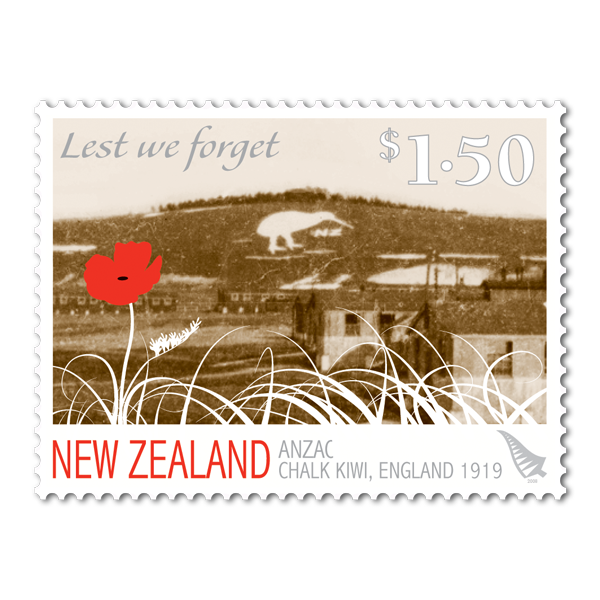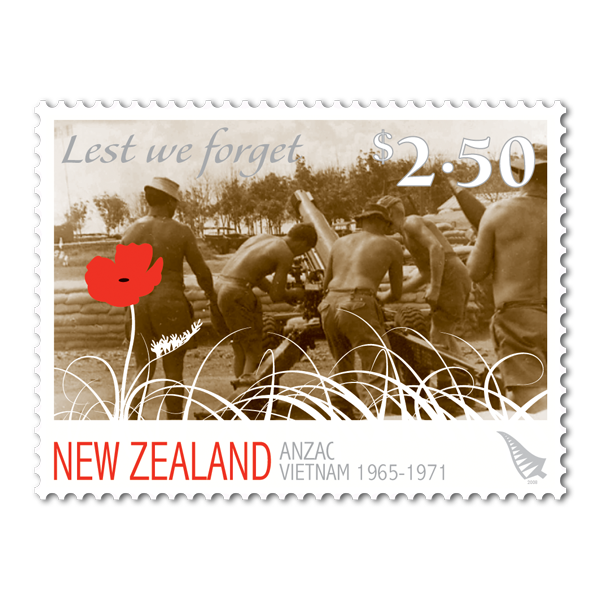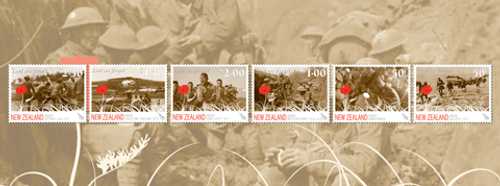Ever since April 1915, when New Zealand and Australian forces united on the battlefield of Gallipoli, the word ‘ANZAC’ (Australian and New Zealand Army Corps) has been part of our national identity. Today, it reminds us of the 30,000 New Zealanders who have lost their lives in the world’s wars – and particularly the men who landed, fought, endured and died at Gallipoli.
Issue information
Far from being lost in the mists of time, the ANZAC story is now stronger than ever. Thousands of all ages gather every year on 25 April (ANZAC Day) to remember our fallen and honour their service to their country. We’re proud of their courage, humbled by their deeds and determined that ‘At the going down of the sun and in the morning, we will remember them’.
New Zealand Post invited you to join us in commemorating ANZAC with the first in a special series that continued for at least the next three years. The first in this series focused on stories of nationhood that helped shape New Zealand as we know it today.
The Symbol of Remembrance
The first day cover for this first in the ANZAC Series brought all six stamps together to tell a story of war. It included the poppy – a symbol of remembrance introduced by the New Zealand Returned Services’ Association in 1922 to support returned soldiers in need and French widows and orphans who manufactured the artificial versions.
Today, poppies are still worn on ANZAC Day, with the proceeds from the Poppy Day Appeal used by the (now renamed) Royal New Zealand Returned and Services’ Association (RSA) to provide welfare services to the veterans and ex-service community.
A Story of Bravery, Unity and National Pride
The ANZAC Series miniature sheet booklet provided authoritative commentary on the story and the stamps from Dr Stephen Clarke, the official historian for the RSA. Stephen is also a consultant for television and film and a frequent contributor to conferences and publications both in New Zealand and internationally.
The booklet included seven miniature sheets, six with individual stamps and one with all six stamps attached, which were only available in the miniature sheet booklet.
Product Listing for The ANZAC Series - Stories of Nationhood
| Image | Title | Description | Price |
|---|---|---|---|
 |
Single Stamp |
Single 50c 'Gallipoli' gummed stamp. The Gallipoli Peninsula in Turkey was the founding location for the ANZAC tradition. In April 1915, this small finger of Europe jutting into the Aegean Sea was a war zone, with New Zealand and Australian troops joining the British in their campaign to defeat the Turks. The campaign was a costly failure for the Allies – among the dead were 2,721 New Zealanders – but it forged a new sense of ANZAC confidence and comradeship. The photograph shows the Auckland Infantry Battalion landing at what would later become ANZAC Cove. |
$0.50 |
 |
Single Stamp |
Single 50c 'Dawn Parade' gummed stamp. Today, the ANZAC spirit lives on in our ANZAC Day commemoration services, held every year on 25 April to honour not only those Kiwis who died at Gallipoli but also those who have served our country in times of war. Traditionally held in the chill light of dawn, the services are attended by military and civilians alike, spanning the generations of the young and the old, the new recruits and the aged veterans. A solemn and emotion-laden ritual, it has become increasingly popular with young people – ensuring that the ANZACs will be remembered for generations to come. |
$0.50 |
 |
Single Stamp |
Single $1.00 'Western Front' gummed stamp. The photograph on our $1.00 stamp illustrates the huge price paid by the soldiers who fought in the battles of World War I – such as the Somme (1916), Passchendaele (1917), and the final liberation of Le Quesnoy (1918). Trench diaries record unimaginable horrors and hardships, but also a camaraderie and sense of identity forged in the heat of battle. More than 4,000 New Zealand soldiers lie with no known graves in the fields of France and Belgium, from a total of 12,500 New Zealand dead. |
$1.00 |
 |
Single Stamp |
Single $1.50 'Chalk Kiwi' gummed stamp. In 1919, a group of New Zealand soldiers waiting to be repatriated home from Sling Camp on England’s Salisbury Plain demonstrated their national pride by making a distinctive mark on the landscape – one that would be remembered long after their departure. They cut a huge figure of a kiwi out of the solid chalk of Beacon Hill, which overlooked the camp – a massive undertaking considering that the kiwi’s beak is 45 metres long and the letters ‘N.Z.’ are 20 metres high! Today, the kiwi is the identifying patch worn by New Zealand Defence Force personnel on overseas operations. |
$1.50 |
 |
Single Stamp |
Single $2.00 'Haka' gummed stamp. Formed in 1939 at the insistence of the great Māori leader and parliamentarian Sir Apirana Ngata and fellow Māori Members of Parliament, the 28th (Māori) Battalion established a formidable reputation as one of New Zealand’s finest fighting forces. Approximately 3,600 men served in the Battalion in Greece, Crete, Italy and North Africa – and suffered many losses, with 618 soldiers killed, 1,710 wounded and 267 taken prisoner or reported missing. The survivors came home to an emotional welcome in 1946, having earned the respect of all New Zealanders and made an enormous contribution to our national pride. |
$2.00 |
 |
Single Stamp |
Single $2.50 'Vietnam' gummed stamp. The war in Vietnam proved to be much more than local – New Zealand’s involvement between 1965 and 1971 also led to much conflict here. Anti-war protests and the war’s general unpopularity left a significant legacy for many Vietnam veterans, who believed their service (and their physical and psychological problems) had not been recognised appropriately. However, the Government and veterans’ organisations are now uniting with Tribute08 in June – a reunion for veterans and their families that will honour their contribution. |
$2.50 |
 |
Miniature Sheet Booklet |
This collectable booklet contained a range of seven miniature sheets, six with individual stamps and one with all six stamps attached, which were only available in the miniature sheet booklet.
|
$19.90 |
 |
First Day Cover | First day cover with stamps affixed. Cancelled on the first day of issue. | $8.50 |
Technical information
| Date of issue: | 2 April 2008 |
|---|---|
| Number of stamps: | Six gummed stamps |
| Denominations: | 50c (x2), $1.00, $1.50, $2.00, $2.50 |
| Stamps, first day cover and miniature sheet booklet designed by: | Cue Design, Wellington |
| Printer and process: | Southern Colour Print Ltd - by offset lithography |
| Number of colours: | Three special colours (Red 485, Brown 464, Silver 877) + black |
| Stamp size and format: | 40mm x 30mm (horizontal) |
| Paper type: | Tullis Russell 104gsm red phosphor gummed stamp paper |
| Number of stamps per sheet: | 25 |
| Perforation gauge: | 14 |
| Special blocks: | Plate/imprint blocks could be obtained by purchasing at least six stamps for a sheet. Barcode blocks were available in both A and B formats |
| Period of sale: | These stamps remained on sale until 1 April 2009. |



